Total Power Factor Smart Contract with Cyber Grid Guard Using Distributed Ledger Technology for Electrical Utility Grid with Customer-Owned Wind Farm
Abstract
1. Introduction
2. Test Model
2.1. Grid and Equipment
2.2. Testing Platform
- The first layer (the physical layer) includes the breakers, power lines, and other grid elements simulated by the real-time simulator.
- The second layer (protection and metering layer) includes the HIL, represented by the relays and meters.
- The third layer (the automation layer) includes the Ethernet switches and remote terminal units.
- The fourth layer includes the CGG system, synchronized time system, trigger-event system, supervisory control and data acquisition, and HMI.
2.3. Three-Phase Diagram and Real-Time Simulation Properties
3. Theory and Equations
3.1. Power Factor
3.2. Average versus Total Power Factor
3.3. Power Factor Convention Signs
4. Methodology
4.1. Total Power Factor Smart Contract
4.2. Time Window Flowchart
4.3. Total Power Factor Smart Contract Flowchart
- If both breakers are closed (Figure 9c), and the measured TPFs on the grid side (TPFBKY) and wind farm side (TPFBKX) are between +0.90 and +1.00 (Figure 9g) for 450 s, then the smart contract does not operate any breakers (Figure 9h). However, if the measured TPFs on the grid side (TPFBKY) and wind farm side (TPFBKX) are smaller than +0.90 (Figure 9i) after 450 s, then the smart contract operates the BKX breaker on the wind farm side (Figure 9j).
- If only one breaker is closed (Figure 9e,f), and the measured TPF on the grid side (TPFBKY) or wind farm side (TPFBKX) is between +0.90 and +1.00 (Figure 9k) for 450 s, then the smart contract does not operate any breakers (Figure 9h). However, if the measured TPF on the grid side (TPFBKY) or wind farm side (TPFBKX) is smaller than +0.90 (Figure 9l) after 450 s, then a warning alarm is triggered (Figure 9m), to indicate a poor power factor without operating the BKY (grid-side) and BKX (wind farm-side) breakers.
5. Cyber Grid Guard with DLT and Smart Contract
5.1. Cyber Grid Guard and Definitions
5.2. Architecture of Smart Contract
6. Results
6.1. Test Scenarios
6.2. Measured Total Power Factor
6.2.1. Normal Situation Tests
6.2.2. Temporary Electrical Fault Situation Tests
7. Discussion
8. Conclusions
Author Contributions
Funding
Data Availability Statement
Acknowledgments
Conflicts of Interest
References
- Rizwan, M.; Hong, L.; Waseem, M.; Ahmad, S.; Sharaf, M.; Shafiq, M. A Robust Adaptive Overcurrent Relay Coordination Scheme for Wind-Farm-Integrated Power Systems Based on Forecasting the Wind Dynamics for Smart Energy Systems. Appl. Sci. 2020, 10, 6318. [Google Scholar] [CrossRef]
- Naheed, K.S.; Louki, S.; Ghedira-Guegan, C.; Benkhelifa, E.; Bani-Hani, A. Blockchain smart contracts: Applications, challenges, and future trends. Peer-Peer Netw. Appl. 2021, 14, 2901–2925. [Google Scholar]
- Foti, M.; Vavalis, M. What blockchain can do for power grids? Blockchain Res. Appl. 2021, 2, 100008. [Google Scholar] [CrossRef]
- Bellaj, B.; Ouaddah, A.; Bertin, E.; Crespi, N.; Mezrioui, A. Drawing the Boundaries Between Blockchain and Blockchain-Like Systems: A Comprehensive Survey on Distributed Ledger Technologies. Proc. IEEE 2024, 112, 247–299. [Google Scholar] [CrossRef]
- AlSobeh, A.M.R. OSM: Leveraging model checking for observing dynamic behaviors in aspect-oriented applications. Online J. Commun. Media Technol. 2023, 13, e202355. [Google Scholar] [CrossRef]
- AlSobeh, A.M.R.; Magableh, A.A. BlockASP: A Framework for AOP-Based Model Checking Blockchain System. IEEE Access 2023, 11, 115062–115075. [Google Scholar] [CrossRef]
- Hong, Z.; Guo, S.; Zhou, E.; Chen, W.; Huang, H.; Zomaya, A. GriDB: Scaling Blockchain Database via Sharding and Off-Chain Cross-Shard Mechanism. Proc. VLDB Endow. 2023, 16, 1685–1698. [Google Scholar] [CrossRef]
- Li, Y.; Wang, J.; Zhang, H. A survey of state-of-the-art sharding blockchains: Models, components, and attack surfaces. J. Netw. Comput. Appl. 2023, 217, 103686. [Google Scholar] [CrossRef]
- Gorzny, J.; Derka, M. A Rollup Comparison Framework. arXiv 2024, arXiv:2404.16150. [Google Scholar] [CrossRef]
- Thibault, L.T.; Sarry, T.; Hafid, A.S. Blockchain Scaling using Rollups: A Comprehensive Survey. IEEE Access 2022, 20, 93039–93054. [Google Scholar] [CrossRef]
- Cai, T.; Chen, W.; Psannis, K.E.; Goudos, S.K.; Yu, Y.; Zheng, Z.; Wan, S. On-Chain and Off-Chain Scalability Techniques chapter. In Blockchain Scalability; Chen, W., Zheng, Z., Huang, H., Eds.; Springer: Singapore. [CrossRef]
- Liu, Y.; Lu, Q.; Zhu, L.; Paik, H.Y.; Staples, M. A Systematic Literature Review on Blockchain Governance. arXiv 2021, arXiv:2105.05460. [Google Scholar] [CrossRef]
- Barceló, E.; Dimić-Mišić, K.; Imani, M.; Brkić, V.S.; Hummel, M.; Gane, P. Regulatory Paradigm and Challenge for Blockchain Integration of Decentralized Systems: Example—Renewable Energy Grids. Sustainability 2023, 15, 2571. [Google Scholar] [CrossRef]
- Zhuang, P.; Zamir, T.; Liang, H. Blockchain for Cyber Security in Smart Grid: A Comprehensive Survey. IEEE Trans. Ind. Inform. 2020, 17, 3–19. [Google Scholar] [CrossRef]
- Chu, H.; Zhang, P.; Dong, H.; Xiao, Y.; Ji, S.; Li, W. A survey on smart contract vulnerabilities: Data sources, detection and repair. Inf. Softw. Technol. 2023, 159, 107221. [Google Scholar] [CrossRef]
- Kolb, J.; AbdelBaky, M.; Katz, R.H.; Culler, D.E. Core Concepts, Challenges, and Future Directions in Blockchain. ACM Comput. Surv. (CSUR) 2020, 53, 1–39. [Google Scholar] [CrossRef]
- Yap, K.Y.; Chin, H.H.; Klemeš, J.J. Blockchain technology for distributed generation: A review of current development, challenges and future prospect. Renew. Sustain. Energy Rev. 2023, 175, 113170. [Google Scholar] [CrossRef]
- Nour, M.; Chaves-Avila, J.P.; Sanchez-Miralles, A. Review of Blockchain Potential Applications in the Electricity Sector and Challenges for Large Scale Adoption. IEEE Access 2022, 10, 47384–47418. [Google Scholar] [CrossRef]
- Ji, Q.; Hu, C.; Duan, Q.; Huang, C.; Zhao, X. Decentralized power grid fault traceability system based on internet of things and blockchain technology. Front. Energy Res. 2023, 10, 861321. [Google Scholar] [CrossRef]
- Piesciorovsky, E.C.; Hahn, G.; Borges Hink, R.; Werth, A.; Lee, A. Electrical substation grid testbed for DLT applications of electrical fault detection, power quality monitoring, DERs use cases and cyber-events. Energy Rep. 2023, 10, 1099–1115. [Google Scholar] [CrossRef]
- He, H.; Luo, Z.; Wang, Q.; Chen, M.; He, H.; Gao, L. Joint Operation Mechanism of Distributed Photovoltaic Power Generation Market and Carbon Market Based on Cross-Chain Trading Technology. IEEE Access 2020, 8, 66116–66130. [Google Scholar] [CrossRef]
- Bokkisam, H.R.; Singh, S.; Acharya, R.M.; Selvan, M.P. Blockchain-based peer-to-peer transactive energy system for community microgrid with demand response management. CSEE J. Power Energy Syst. 2022, 8, 198–211. [Google Scholar]
- Liang, G.; Weller, S.R.; Luo, F.; Zhao, J.; Dong, Z.Y. Distributed Blockchain-Based Data Protection Framework for Modern Power Systems Against Cyber Attacks. IEEE Trans. Smart Grid. 2019, 10, 3162–3173. [Google Scholar] [CrossRef]
- Mnatsakanyan, A.; Albeshr, H.; Al Marzooqi, A.; Bilbao, E. Blockchain-Integrated Virtual Power Plant Demonstration. In Proceedings of the 2020 2nd International Conference on Smart Power and Internet Energy Systems, Bangkok, Thailand, 15–18 September 2020; pp. 172–175. [Google Scholar]
- Cioara, T.; Antal, M.; Mihailescu, V.T.; Antal, C.D.; Anghel, I.M.; Mitrea, D. Blockchain-Based Decentralized Virtual Power Plants of Small Prosumers. IEEE Access 2021, 9, 29490–29504. [Google Scholar] [CrossRef]
- Schweitzer Engineering Laboratories Inc. SEL-700G Generator and Intertie Protection Relays Instruction Manual. Available online: https://selinc.com/products/700G/docs/ (accessed on 9 October 2024).
- PowerLogic™ PM5500/PM5600/PM5700 Series User Manual. Schneider Electric, Document Number HRB1684301, Version 16, 31 December 2023. pp. 1–238. Available online: https://www.se.com/us/en/download/document/HRB1684301/ (accessed on 9 October 2024).
- Piesciorovsky, E.C.; Borges Hink, R.; Werth, A.; Hahn, G.; Lee, A.; Richards, J.; Polsky, Y. Assessment of the Electrical Substation-Grid Test Bed with Inside/Outside Devices and Distributed Ledger; ORNL/TM-2022/1840; Oak Ridge National Laboratory: Oak Ridge, TN, USA, 2022; pp. 1–87. [Google Scholar]
- Piesciorovsky, E.C.; Borges Hink, R.; Werth, A.; Hahn, G.; Lee, A.; Polsky, Y. Assessment and Commissioning of Electrical Substation Grid Testbed with a Real-Time Simulator and Protective Relays/Power Meters in the Loop. Energies 2023, 16, 4407. [Google Scholar] [CrossRef]
- Borges Hink, R.; Hahn, G.; Werth, A.; Piesciorovsky, E.C.; Lee, A.; Monday, W.; Polsky, Y. Oak Ridge National Laboratory Pilot Demonstration of an Attestation and Anomaly Detection Framework Using Distributed Ledger Technology for Power Grid Infrastructure; ORNL/TM-2022/2527; Oak Ridge National Laboratory: Oak Ridge, TN, USA, 2022; pp. 1–56. [Google Scholar]
- IEEE Std 1459TM-2010; Standard Definitions for the Measurement of Electric Power Quantities Under Sinusoidal, Nonsinusoidal, Balanced, or Unbalanced Conditions. IEEE Power & Energy Society: Piscataway, NJ, USA, 2010; pp. 1–40.
- Introduction to Power Factor. Introduction to Power Factor. Wyandotte Municipal Services, Revision 15 September 2004. pp. 1–12. Available online: https://cms2.revize.com/revize/wyandottems/document_center/Electric/PowerFactor.pdf (accessed on 9 October 2024).
- Zhao, C.; Han, D.; Li, C.; Wang, H. A Blockchain Consensus Mechanism to Optimize Reputation-Based Distributed Energy Trading in Urban Energy System. IEEE Access 2024, 12, 53698–53712. Available online: https://ieeexplore.ieee.org/document/10496579 (accessed on 13 October 2024). [CrossRef]
- Yao, S.; Tian, X.; Chen, J.; Xiong, Y. Privacy preserving distributed smart grid system based on Hyperledger Fabric and Wireguard. Int. J. Netw. Manag. 2023, 33, e2193. [Google Scholar] [CrossRef]
- Zhao, Z.; Guo, J.; Luo, X.; Xue, J.; Sing Lai, C.; Xu, Z.; Lei Lai, L. Energy Transaction for Multi-Microgrids and Internal Microgrid Based on Blockchain. IEEE Access 2020, 8, 144362–144372. [Google Scholar] [CrossRef]
- Sikeridis, D.; Bidram, A.; Devetsikiotis, M.; Reno, M.J. A Blockchain-Based Mechanism for Secure Data Exchange in Smart Grid Protection Systems. In Proceedings of the 2020 IEEE 17th Annual Consumer Communications & Networking Conference (CCNC), Las Vegas, NV, USA, 10–13 January 2020; pp. 1–6. [Google Scholar]
- Edvard, C. Six Common Bus Configurations in Substations up to 354 kV. Electrical Engineering Portal, 18 March 2019. Available online: https://electrical-engineering-portal.com/bus-configurations-substations-345-kv (accessed on 9 October 2024).
- Schweitzer Engineering Laboratories Inc. SEL 735 Power Quality and Revenue Meter Instruction Manual. Available online: https://selinc.com/products/735/docs/ (accessed on 9 October 2024).
- Schweitzer Engineering Laboratories Inc. SEL 421-4, -5, Protection, Automation, and Control System Instruction Manual. Available online: https://selinc.com/products/421/docs/ (accessed on 9 October 2024).
- Schweitzer Engineering Laboratories Inc. SEL 451-5 Protection, Automation, and Bay Control System and SEL 400 Series Relays Instruction Manual. Available online: https://selinc.com/products/451/docs/ (accessed on 9 October 2024).
- Schweitzer Engineering Laboratories Inc. SEL 351S Protection System Instruction Manual. Available online: https://selinc.com/products/351S/docs/ (accessed on 9 October 2024).
- Du, B.; He, Y.; An, B.; Zhang, C. Remaining Useful Performance Estimation for Complex Analog Circuit Based on Maximal Information Coefficient and Bidirectional Gate Recurrent Unit. IEEE Access 2020, 8, 102449–102466. [Google Scholar] [CrossRef]
- Piesciorovsky, E.C.; Smith, T.; Mukherjee, S.K.; Marshall, M.W. A Generic Method for Interfacing IEDs using Low Voltage Interfaces to Real-time Simulators with Hardware in the Loop. Electr. Power Syst. Res. J. 2021, 199, 107431. [Google Scholar] [CrossRef]
- Piesciorovsky, E.C.; Schulz, N.N. Comparison of Programmable Logic and Setting Group Methods for Adaptive Overcurrent Protection in Microgrids. Electr. Power Syst. Res. J. 2017, 151, 273–282. [Google Scholar] [CrossRef]
- Piesciorovsky, E.C.; Schulz, N.N. Fuse Relay Adaptive Overcurrent Protection Scheme for Microgrid with Distributed Generators. IET Gener. Transm. Distrib. 2016, 11, 540–549. [Google Scholar] [CrossRef]
- S&C Electric Company. Total Clearing Time—Current Characteristic Curves Positrol® Fuse Links–S&C “T” Speed (TCC 170-6-2). Available online: https://www.sandc.com/en/products--services/products/positrol-fuse-links/ (accessed on 9 October 2024).
- DTE Energy. Electric Choice Understanding Power Factor. Available online: https://www.dteenergy.com/content/dam/dteenergy/deg/website/business/service-request/electric/electric-choice/powerFactor.pdf (accessed on 9 October 2024).
- Voloh, I.; Ernst, T. Review of Capacitor Bank Control Practices, GE Grid Solutions. In Proceedings of the 72nd Annual Conference for Protective Relay Engineers, Texas A&M University, College Station, TX, USA, 25–28 March 2019; pp. 1–13. [Google Scholar]
- New, W.C. Load Shedding, Load Restoration and Generator Protection Using Solid-state and Electromechanical Underfrequency Relays. GET-6449, GE Power Management, 215 Anderson Avenue, Markham, Ontario, Canada. Available online: https://www.gevernova.com/grid-solutions/products/applications/get6449.pdf (accessed on 9 October 2024).
- ANSI/IEEE Standard C37.2; Standard for Electrical Power System Device Function Numbers, Acronyms, and Contact Designations. IEEE Power and Energy Society: Piscataway, NJ, USA, 3 October 2008.
- Hosseinzadeh, H. Distribution System, Protection ES586B: Power System Protection. University of Western Ontario, 5 May 2008. pp. 1–16. Available online: https://www.eng.uwo.ca/people/tsidhu/documents/es586b-hesam%20hosseinzadeh-250441131.pdf (accessed on 9 October 2024).
- Dreyer, J.; Fischer, M.; Tönjes, R. Performance Analysis of Hyperledger Fabric 2.0 Blockchain Platform. In Proceedings of the Workshop on Cloud Continuum Services for Smart IoT Systems, New York, NY, USA, 16–19 November 2020; pp. 32–38. [Google Scholar] [CrossRef]
- Zhou, Y.; Manea, A.N.; Hua, W.; Wu, J.; Zhou, W.; Yu, J. Application of Distributed Ledger Technology in Distribution Networks. Proc. IEEE 2022, 110, 1963–1975. [Google Scholar] [CrossRef]
- Liu, Y.; He, J.; Li, X.; Chen, J.; Liu, X.; Peng, S.; Cao, H.; Wang, Y. An overview of blockchain smart contract execution mechanism. J. Ind. Inf. Integr. 2024, 41, 100674. [Google Scholar] [CrossRef]
- Stefanescu, D.; Montalvillo, L.; Galán-García, P.; Unzilla, J.; Urbieta, A. A Systematic Literature Review of Lightweight Blockchain for IoT. IEEE Access 2022, 10, 123138–123159. [Google Scholar] [CrossRef]
- Van Rensburg, M.; Dolezilek, D.; Dearien, J. Case Study: Using IEC 61850 Network Engineering Guideline Test Procedures to Diagnose and Analyze Ethernet Network Installations. In Proceedings of the PAC World Africa Conference, Johannesburg, South Africa, 12–13 November 2015; pp. 1–10. [Google Scholar]
- Habib, A.A.; Hasan, M.K.; Alkhayyat, A.; Islam, S.; Sharma, R.; Alkwai, L.M. False data injection attack in smart grid cyber physical system: Issues, challenges, and future direction. Comput. Electr. Eng. 2023, 107, 108638. [Google Scholar] [CrossRef]
- Daeli, A.; Mohagheghi, S. Power Grid Infrastructural Resilience against Extreme Events. Energies 2023, 16, 64. [Google Scholar] [CrossRef]
- Immaniar, D.; Aryani, A.A.; Ula, S.Z. Challenges Smart Grid in Blockchain Applications. Blockchain Front. Technol. 2023, 2, 1–9. [Google Scholar] [CrossRef]



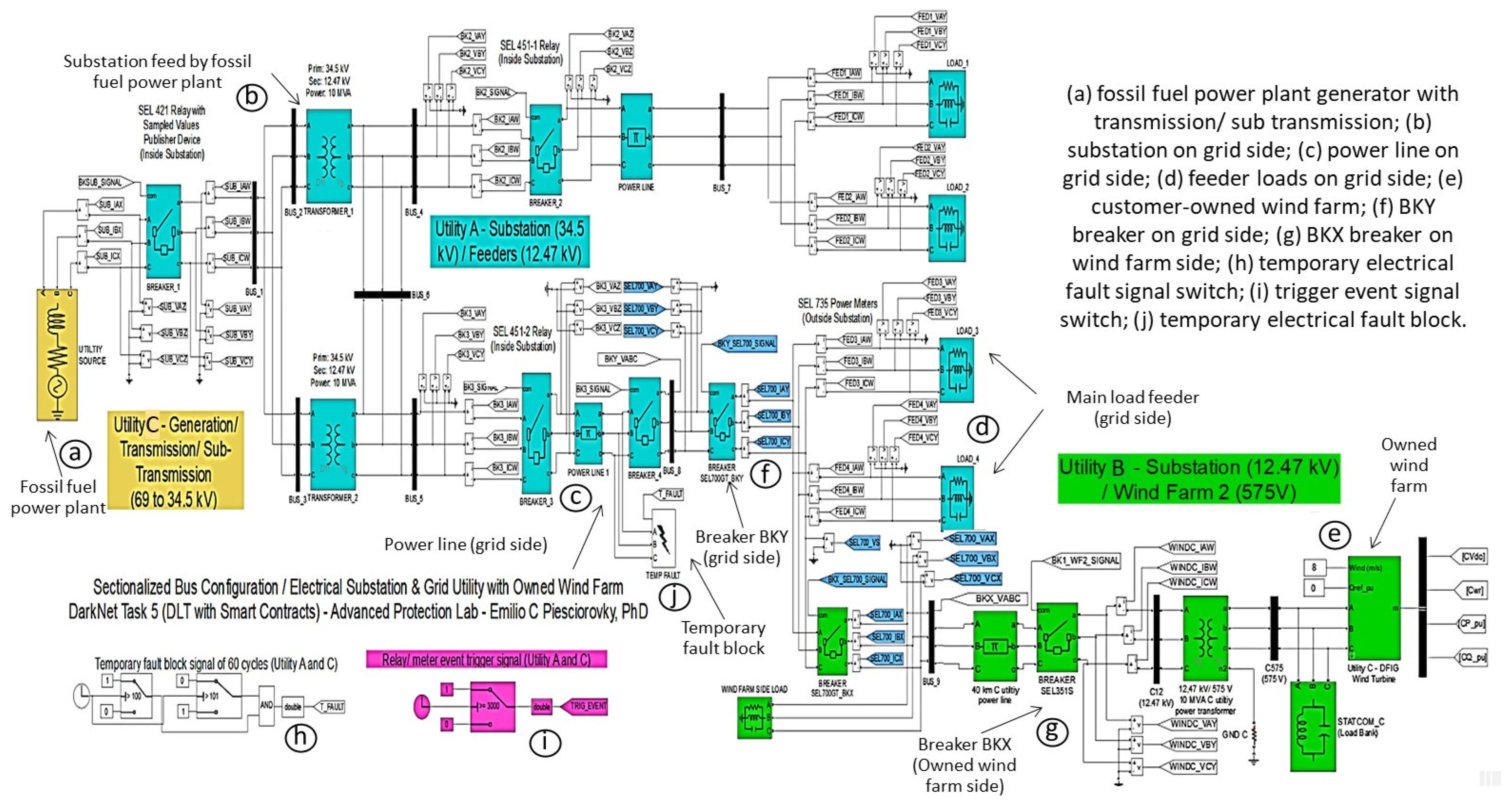




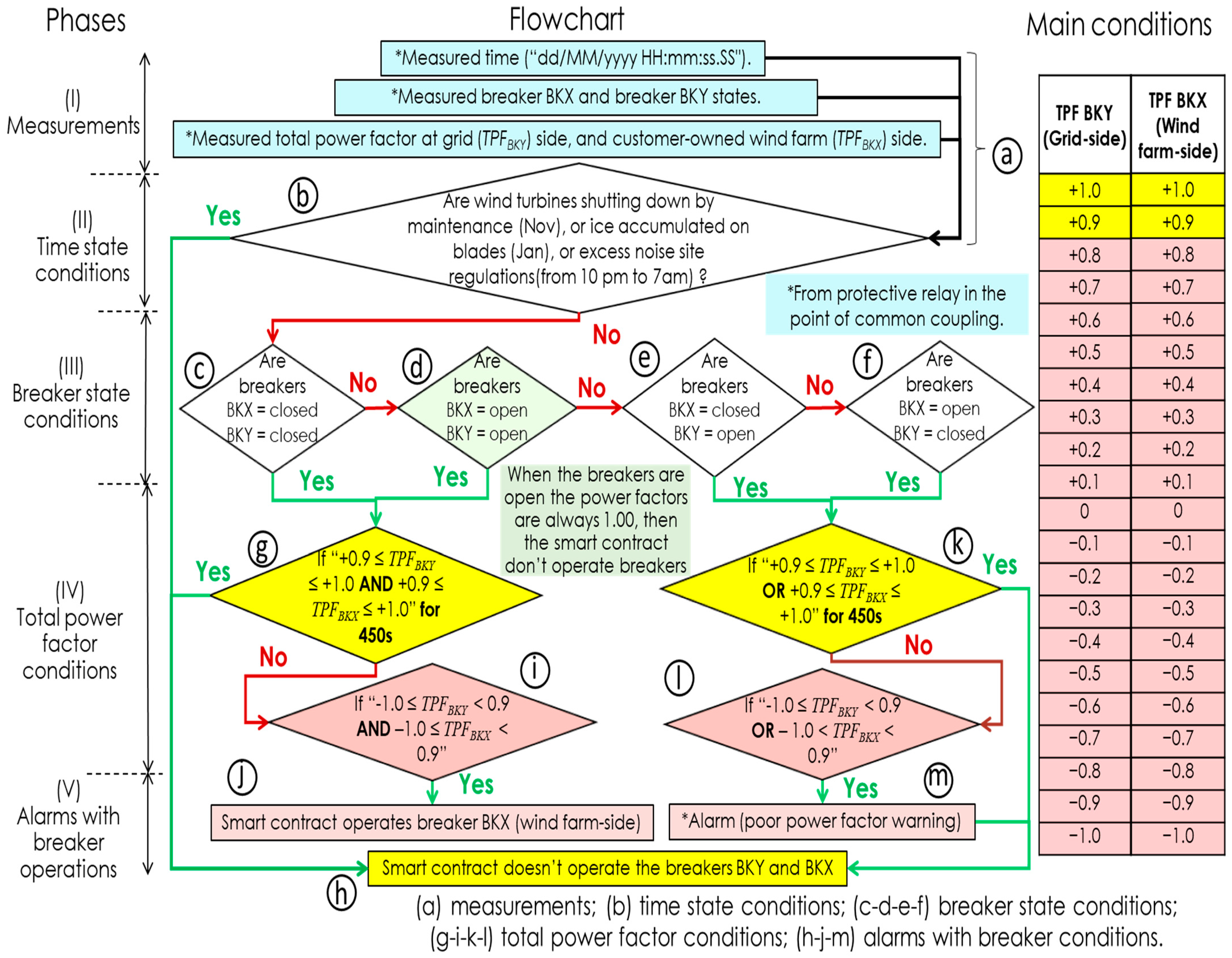
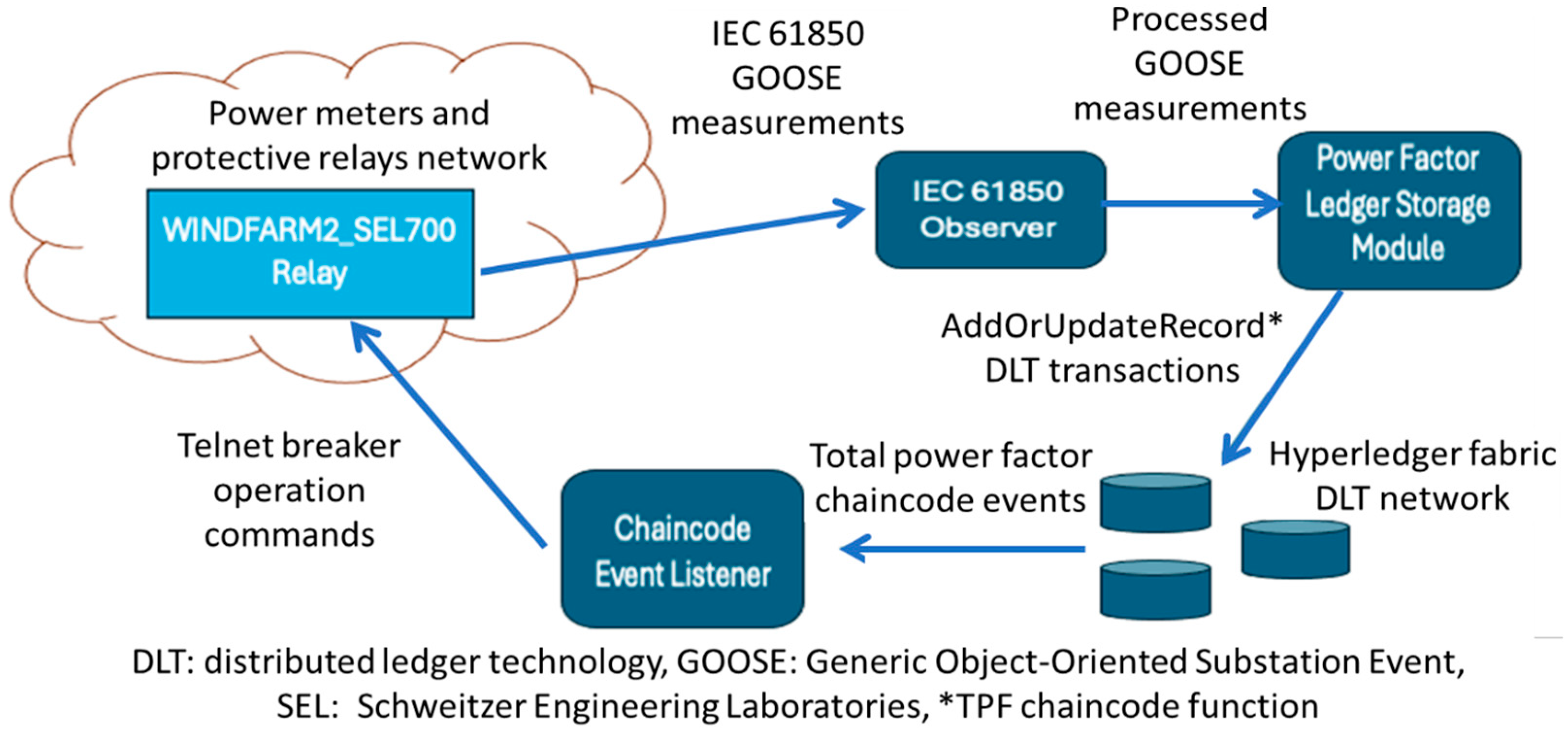
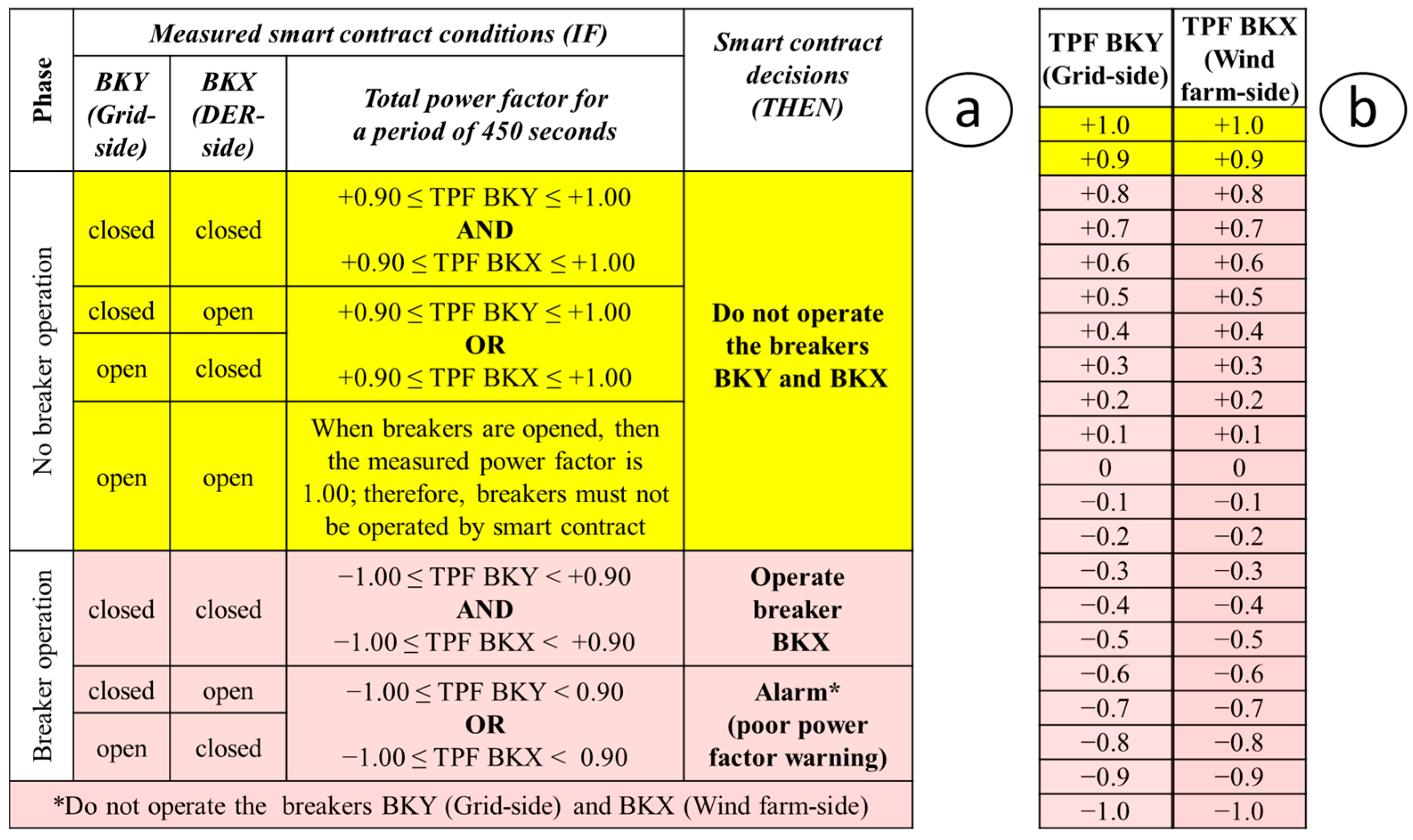
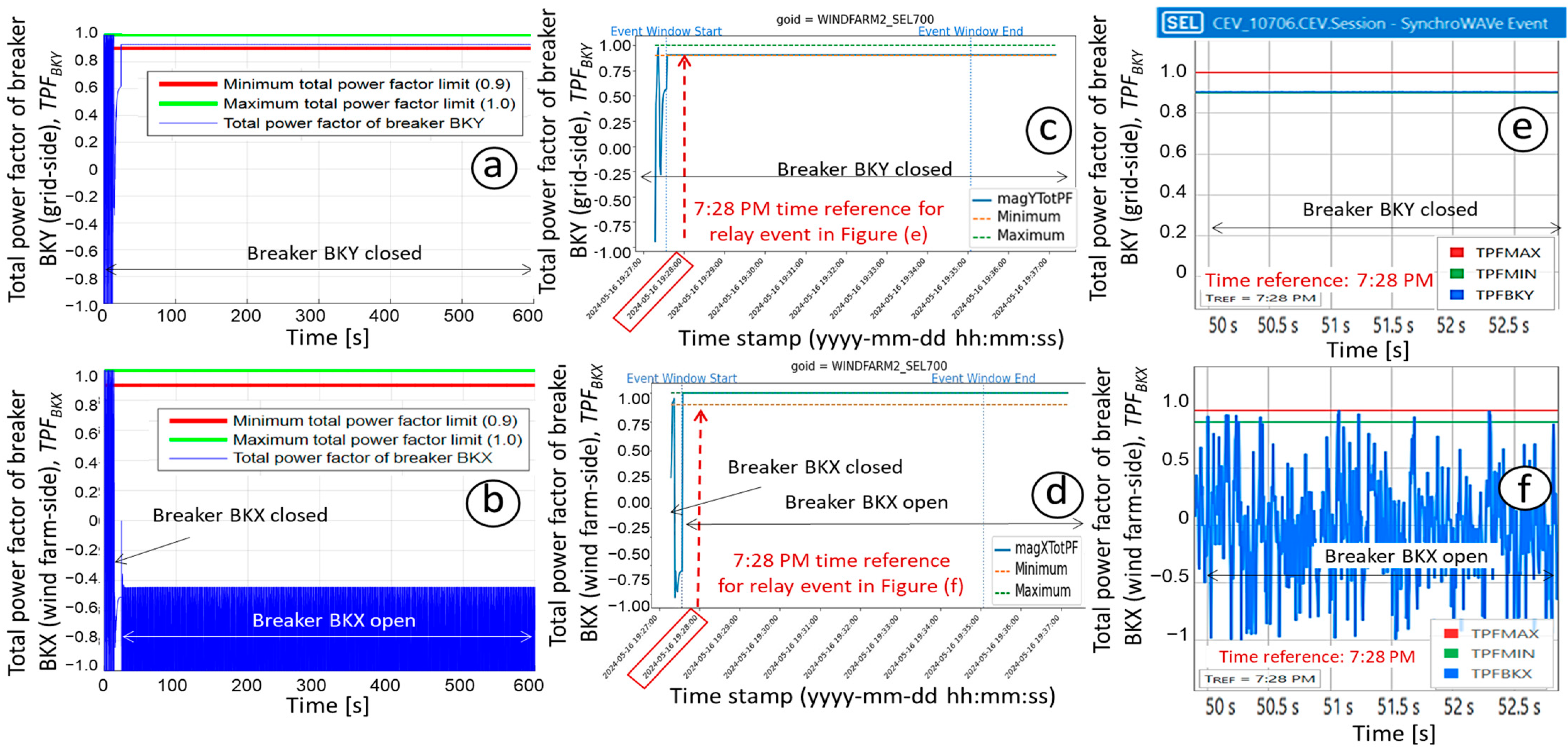
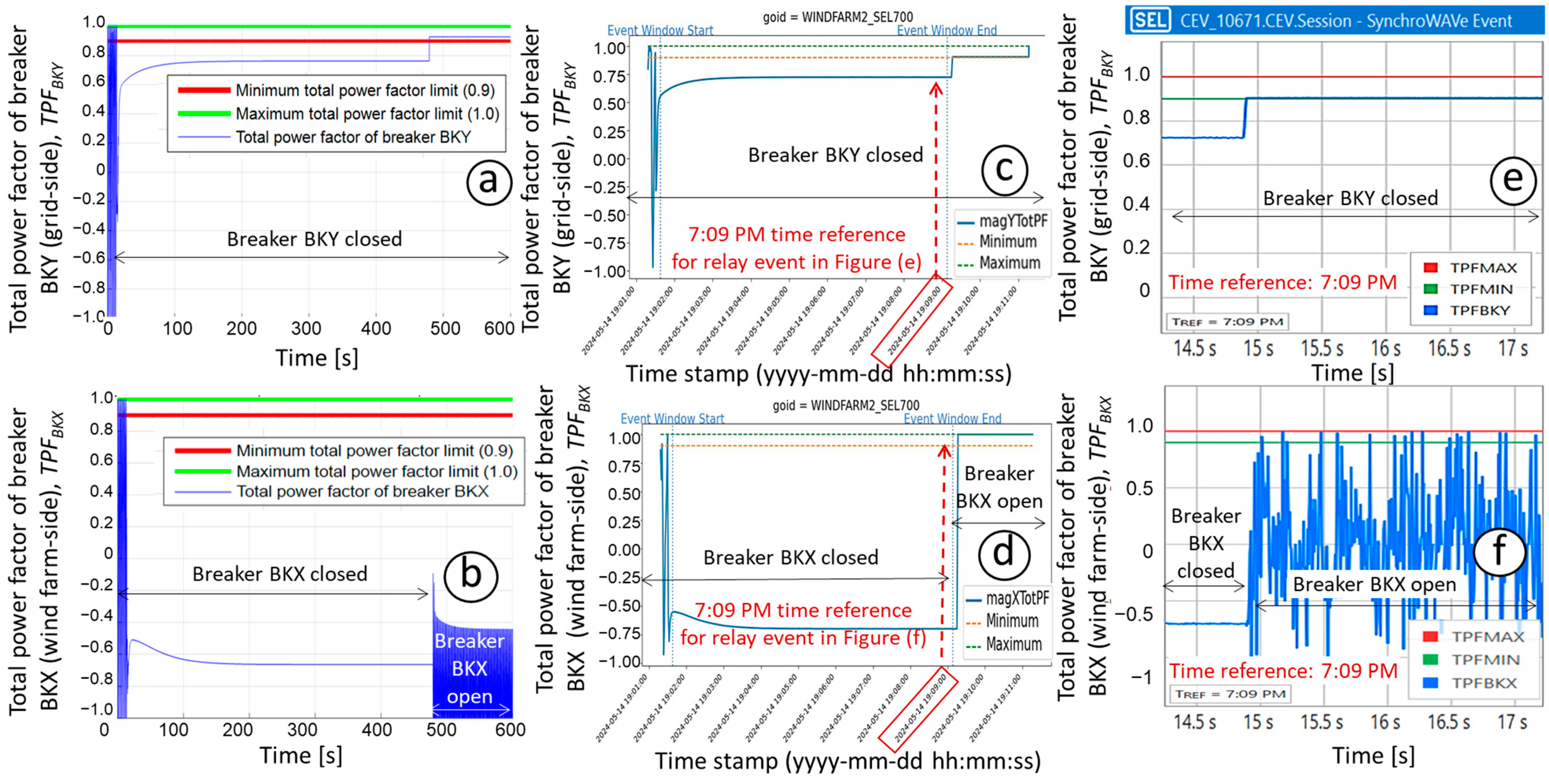

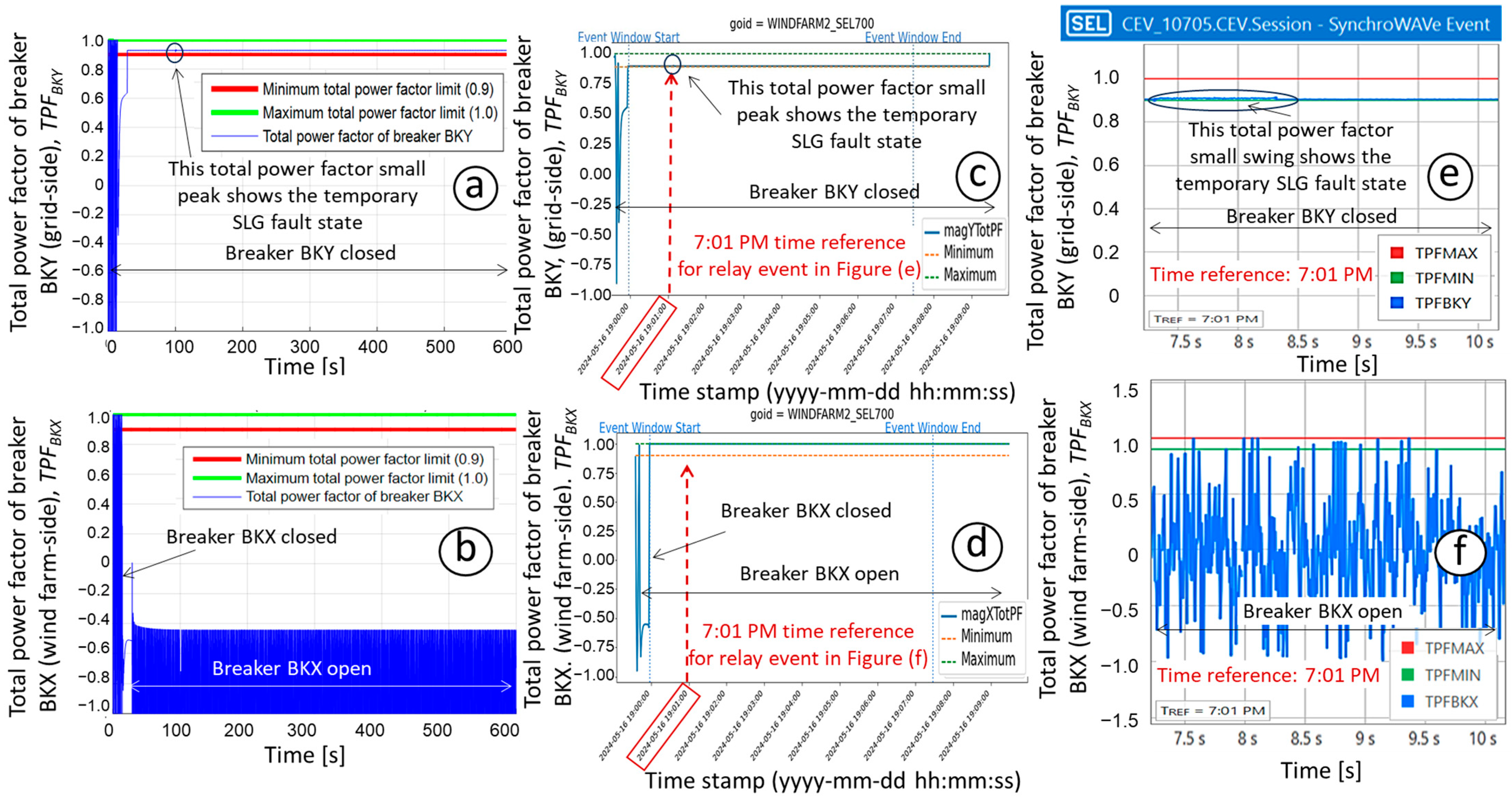
| Field | Novelties |
|---|---|
| Application | Operating a power quality method with a customer-owned DER, based on reducing the reactive energy in the grid-side power lines using a TPF smart contract with CGG and DLT, following the use of traditional power quality methods like capacitor banks, load shedding, or transformer/load tap changers. |
| Data Security | Using the CGG with DLT and smart contracts for securing data from the relay located at the PCC between electrical utility grid and customer-owned DER. |
| Assessment | Evaluating the TPF smart contract in an advanced substation grid testbed with a real-time simulator using DLT nodes and relay in-the-loop instead of using software simulations. |
| Protection Elements | Protection Number | Protection Description | Time Setting | Time Range (s) |
|---|---|---|---|---|
| X side frequency | 81 | 81: Frequency protection on the BKX breaker side | Frequency delay time | 0.00 to 400.00 |
| Y side frequency | 81 | 81: Frequency protection on the BKY breaker side | Frequency delay time | 0.00 to 400.00 |
| V/Hz | 24 | 24: Overexcitation protection, ratio of the voltage to frequency | Reset time | 0.00 to 400.00 |
| Terms | Definitions |
|---|---|
| Cyber Grid Guard (CGG) | Cyber Grid Guard is a modular software framework that performs data integrity attestation using a storage layer consisting of a database and DLT. |
| Distributed Ledger Technology (DLT) | Distributed Ledger Technology (DLT) refers to distributed and decentralized secure database platforms that use consensus mechanisms to reach agreements on state. The most common types of DLT are implemented using blockchains. |
| Smart Contracts | Smart contracts are automated programs that run on top of DLTs and enforce terms and conditions on transaction data and are executed in a distributed manner. |
| On-chain | On-chain refers to functionality or data that exist in the distributed ledger. |
| Off-Chain | Off-Chain refers to functionality or data that exist outside of the distributed ledger (e.g., in a traditional database). |
| Field Name | Data Type | Data Description |
|---|---|---|
| magXTotPF | Float32 | Total power factor for X. |
| magYTotPF | Float32 | Total power factor for Y. |
| breakerXOpen | Boolean | Status of breaker X (open = 1, closed = 0). |
| breakerYOpen | Boolean | Status of breaker Y (open = 1, closed = 0). |
| *† TEST 1: Normal situation and no breaker operation. | Title: Main feeder loads are connected only with the grid-side breaker (BKY) that measures a TPF ≥ +0.90; thus, the smart contract does not operate any breakers. |
| Description: Initially the grid-side breaker (BKY) is closed and the wind farm-side breaker (BKX) is opened. The wind farm–side load has 2.06 MW, +1000 VAR, −1000 VAR. The fossil fuel power plant (Utility C) and the substation (Utility A) are connected to the main feeder loads (2 × [1.25 MW, +0.5 MVAR, −1000 VAR]). The grid-side breaker (BKY) shows a TPF ≥ +0.90, meaning reactive losses are practically none on the grid-side power line. The TPF smart contract does not operate the breakers or the grid side (BKY) or wind farm (BKX) for a TPF ≥ +0.90. | |
| * TEST 2: Normal situation and wind farm-side breaker (BKX) operation. | Title: Main feeder loads are connected with the grid-side breaker (BKY) and wind farm-side breaker (BKY); then the grid-side breaker (BKY) measures a poor TPF, and the wind farm-side breaker (BKX) is opened. |
| Description: Initially the grid-side breaker (BKY) is closed and the wind farm-side breaker (BKX) is closed. The wind farm-side load has 2.06 MW, +1000 VAR, −1000 VAR. The fossil fuel power plant (Utility C) through the substation (Utility A) and the wind farm are connected to the main feeder loads (2 × [1.25 MW, +0.5 MVAR, −1000 VAR]). The grid-side breaker (BKY) shows a TPF < +0.90, meaning that the TPF in the grid-side power line generates reactive losses. The wind farm-side breaker (BKX) is opened after 400 s, and the TPF is ≥ +0.90 at the grid-side breaker (BKY). | |
| *† TEST 3: Temporary 3LG electrical fault situation and no breaker operation. | Title: Main feeder loads are connected only with the grid-side breaker (BKY) and measure a TPF > +0.90. Thus, a temporary 3LG electrical fault of 1 s (60 cycles) at the grid-side power line is set, but the smart contract does not operate any breaker because the electrical fault is cleared. |
| Description: Initially the grid-side breaker (BKY) is closed and the wind farm–side breaker (BKX) is opened. The wind farm–side load has 2.06 MW, +1000 VAR, −1000 VAR. The fossil fuel power plant (Utility C) through the substation (Utility A) is connected to the main feeder loads (2 × [1.25 MW, +0.5 MVAR, −1000 VAR]). Then, a temporary 3LG electrical fault of 1 s (60 cycles) at the end of the grid-side power line is set at 100 s. The grid-side breaker (BKY) shows a swing and poor power factor during the fault state, until the fault is clears by itself. However, the TPF smart contract does not operate the grid-side breaker (BKY), and the wind farm–side breaker (BKX) remains open. | |
| *† TEST 4: Temporary SLG electrical fault situation and no breaker operation. | Title: Main feeder loads are connected only with the grid-side breaker (BKY) and measure a TPF > +0.90. Thus, a temporary SLG electrical fault of 1 s (60 cycles) at the grid-side power line is set, but the smart contract does not operate any breaker because the electrical fault is cleared. |
| Description: Initially the grid-side breaker (BKY) is closed and the wind farm-side breaker (BKX) is opened. The wind farm-side load has 2.06 MW, +1000 VAR, −1000 VAR. The fossil fuel power plant (Utility C) and the substation (Utility A) are connected to the main feeder loads (2 × [1.25 MW, +0.5 MVAR, −1000 VAR]). Then, a temporary SGL electrical fault of 1 s (60 cycles) at the end of the grid-side power line is set at 100 s. The grid-side breaker (BKY) swings and shows a poor power factor during the fault state, until the fault clears by itself. However, the TPF smart contract does not operate the grid-side breaker (BKY), and the wind farm-side breaker (BKX) remains open. |
Disclaimer/Publisher’s Note: The statements, opinions and data contained in all publications are solely those of the individual author(s) and contributor(s) and not of MDPI and/or the editor(s). MDPI and/or the editor(s) disclaim responsibility for any injury to people or property resulting from any ideas, methods, instructions or products referred to in the content. |
© 2024 by the authors. Licensee MDPI, Basel, Switzerland. This article is an open access article distributed under the terms and conditions of the Creative Commons Attribution (CC BY) license (https://creativecommons.org/licenses/by/4.0/).
Share and Cite
Piesciorovsky, E.C.; Hahn, G.; Borges Hink, R.; Werth, A. Total Power Factor Smart Contract with Cyber Grid Guard Using Distributed Ledger Technology for Electrical Utility Grid with Customer-Owned Wind Farm. Electronics 2024, 13, 4055. https://doi.org/10.3390/electronics13204055
Piesciorovsky EC, Hahn G, Borges Hink R, Werth A. Total Power Factor Smart Contract with Cyber Grid Guard Using Distributed Ledger Technology for Electrical Utility Grid with Customer-Owned Wind Farm. Electronics. 2024; 13(20):4055. https://doi.org/10.3390/electronics13204055
Chicago/Turabian StylePiesciorovsky, Emilio C., Gary Hahn, Raymond Borges Hink, and Aaron Werth. 2024. "Total Power Factor Smart Contract with Cyber Grid Guard Using Distributed Ledger Technology for Electrical Utility Grid with Customer-Owned Wind Farm" Electronics 13, no. 20: 4055. https://doi.org/10.3390/electronics13204055
APA StylePiesciorovsky, E. C., Hahn, G., Borges Hink, R., & Werth, A. (2024). Total Power Factor Smart Contract with Cyber Grid Guard Using Distributed Ledger Technology for Electrical Utility Grid with Customer-Owned Wind Farm. Electronics, 13(20), 4055. https://doi.org/10.3390/electronics13204055







